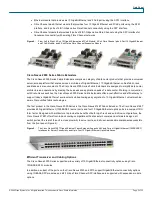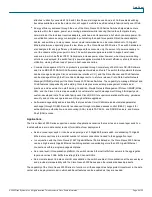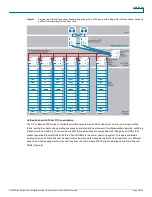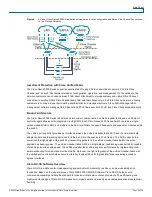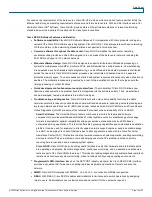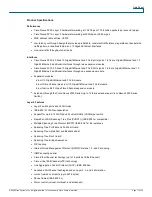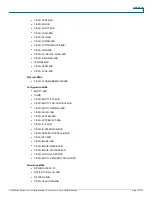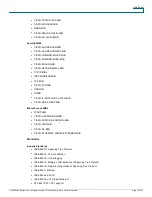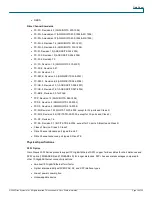
Data Sheet
© 2009 Cisco Systems, Inc. All rights reserved. This document is Cisco Public Information.
Page 5 of 22
Features and Benefits
The Cisco Nexus 5000 Series’ rich feature set makes it ideal for top-of-rack, middle-of-row, or end-of-row access-
layer applications. It protects investments in data center racks with standards based 10 Gigabit Ethernet and FCoE
features, and virtual machine awareness features that allow IT departments to consolidate networks based on their
own requirements and timing. The combination of high port density, lossless Ethernet, wire-speed performance, and
extremely low latency makes the switch family ideal for meeting the growing demand for 10 Gigabit Ethernet that can
support unified fabric in enterprise and service provider data centers, protecting enterprises’ investments. The switch
family has sufficient port density to support single and multiple racks fully populated with blade and rack-mount
servers.
●
Built for today’s data centers, the switches are designed just like the servers they support. Ports and power
connections are at the rear, closer to server ports, helping keep cable lengths as short and efficient as
possible, delivering benefits traditionally offered on blade servers to rack servers as well. Hot-swappable
power and fan modules can be accessed from the front panel, where status lights offer an at-a-glance view of
switch operation. Front-to-back cooling is consistent with server designs, supporting efficient data center hot-
and cold-aisle designs. Serviceability is enhanced with all customer-replaceable units accessible from the
front panel. The use of SFP+ ports offers increased flexibility, enabling use of a range of interconnect
solutions, including copper Twinax cable for short runs and fiber for long runs.
●
IEEE DCB enables Ethernet fabrics to support lossless transmission to increase network scalability, support
I/O consolidation, ease management of multiple traffic flows, and optimize performance. Although
implementing SAN consolidation requires only the lossless fabric provided by the Ethernet pause
mechanism, the Cisco Nexus 5000 Series provides additional features that create an even more easily
managed, high-performance, unified network fabric. The IEEE DCB and related standards summarized in
Table 3 are supported by the Cisco Nexus 5000 Series Switches.
Table 3.
IEEE DCB Features and Benefits
Feature
Business Benefit
Priority Flow Control (PFC): IEEE
802.1Qbb
●
Simplifies management of multiple traffic flows over a single network link
●
Creates lossless behavior for Ethernet by allowing class-of-service (CoS)-based flow control
Enhanced Transmission Selection: IEEE
802.1Qaz
Enables consistent management of quality of service (QoS) at the network level by providing consistent
scheduling of different traffic types (IP, storage, etc.)
Data Center Bridging Exchange (DCBX)
Protocol: IEEE 802.1AB
Simplifies network deployment and reduces configuration errors by providing autonegotiation of IEEE
DCB features between the NIC and the switch and between switches
Congestion Notification: IEEE 802.1Qau
Pushes congestion to network edges, providing better control over QoS; the Cisco Nexus 5000 Series
hardware supports a precursor to IEEE 802.1Qau called Backward Congestion Notification (BCN),
which will be made available based on availability of other system components, such as adapters and
core switches and routers
●
FCoE is a standards-based upper-layer protocol that maps the Fibre Channel Protocol (FCP) and services
onto Layer 2 Ethernet. It is a straightforward encapsulation of Fibre Channel within Ethernet that preserves
existing Fibre Channel network management models and tools, helping protect investments in software and
staff training.
●
Cisco unified fabric consolidates all data center I/O onto Layer 2 Ethernet. Unified fabric reduces capital and
operating costs by reducing the number of server adapters, cables, and upstream switches needed. All I/O
(LAN, SAN, and cluster) typically is consolidated onto two Ethernet links. IEEE DCB and FCoE enable the
incorporation of Fibre Channel frames into a unified fabric, facilitating wire-once strategies in which all servers
become capable of SAN connection. A standard and uniform approach to I/O enhances server and storage
consolidation strategies. The Cisco Nexus 5000 Series also connects to existing native Fibre Channel
networks, protecting current investments in storage networks. Additionally, the Cisco Nexus 5000 Series



